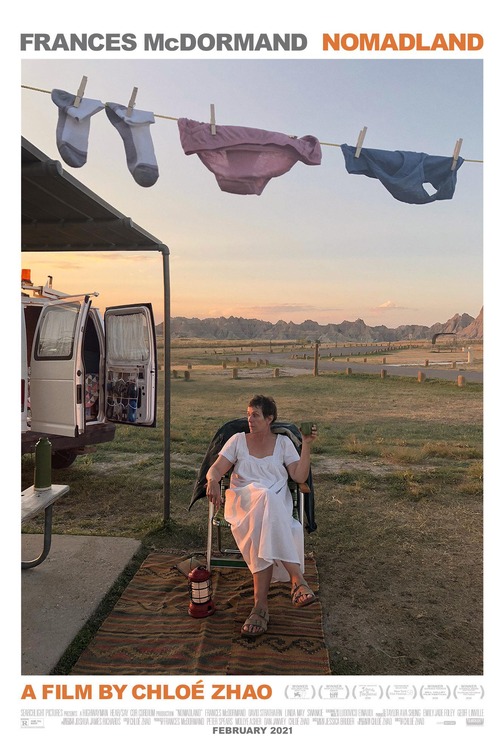
Nomadland: Surviving America in the Twenty-First Century was published by journalist Jessica Bruder in 2017. She wrote a non-fiction book detailing the phenomenon of nomads which significantly increased after 2009 in the wake of the Great Recession. Older, adventuresome types adopted a transient existence, taking to the road in RVs, vans, and campers. These so-called “workampers” combine work and camping, traveling around the United States in search of full or part-time employment. Vagabonds form a growing community that number in the tens of thousands.
Life is about the journey. The chronicle is ostensibly about a woman named Fern. Her trek begins when the U.S. Gypsum plant in Empire, Nevada shuts down in 2011. It had been there for 88 years. The mine’s closure led to the town’s economic collapse and the cancellation of its zip code. Her husband has recently died. Fern decides to sell most of her belongings. She uses the money to purchase a van and travel the country searching for jobs. This character is brilliantly realized by Frances McDormand. The actress melts into her surroundings. She impresses the viewer not as a thespian playing a role but as the authentic embodiment of a soul. McDormand has won 2 Oscars, one for Fargo in 1997 and another for Three Billboards Outside Ebbing, Missouri in 2018. It’s not so far-fetched that she just might win her third. Her personification is yet another testament to her talent.
Nomadland cleverly blurs the line between documentary and fiction. The ability to present a person’s experiences, honestly, without artifice is indeed a gift . This is director Chloé Zhao’s third feature, having previously directed Songs My Brothers Taught Me (2015) and The Rider (2017). McDormand works in the Hollywood realm. So does actor David Strathairn who pops up in a supporting part here as a potential love interest. However, a fundamental component is the casting of non-actors who were also portrayed in the text. The story is elevated by the actual individuals depicting somewhat fictional versions of themselves. Linda May, Charlene Swankie, and Bob Wells are three examples. This is a heartfelt achievement that empathizes with these wanderers. Their humanity is a big reason why this film is so effective.
Nomadland highlights the landscape as much as it honors people. Fern’s expedition across the American West not only offers a glimpse of gorgeous vistas and stunning sunsets but also unforgiving cold climates and harsh conditions. Joshua James Richards’ cinematography is a key element of director Chloé Zhao’s portrait. I’m ready for a coffee table book that highlights images from the production. The narrative is not plot-driven, so it may take some time to embrace its gentle rhythms. Some vignettes are more compelling than others. This is a leisurely-paced account that gently drifts along. Like the movie, the central protagonist ambles through life. Initially, it presents a depressing tale of an economy in decline — vagabonds who have sacrificed the comfort of an established residence in order to survive. Nomadland ultimately celebrates strength and adaptability — the resilience and creativity of the indomitable human spirit. These Americans may have given up a permanent home but they have not given up hope.
11-25-20

6 Responses
Can’t help but notice the old publishing date on this post. Was there an embargo on reviews for this one? I believe the film came out on Hulu this past weekend?
You’re sharp. No embargo. It was my own doing. I saw it back in November and wrote a rough draft then. I don’t see the point of posting a review for a film no one can see. I waited until it was streaming on Hulu to actually post. 😊
I like your style. Too many times have I read early reviews from critics who seem to relish the opportunity to be first in line. Comes across obvious and honestly a little haughty.
Agreed. It’s particularly obnoxious when people brag on Twitter they’re watching a film for a third time when the film hasn’t even been released yet.
This was good. Very raw, like a documentary. I liked that they used real people. Nice touch. 3 1/2 ⭐️
I think using the actual people really helped Frances McDormand’s performance. She fit right in.